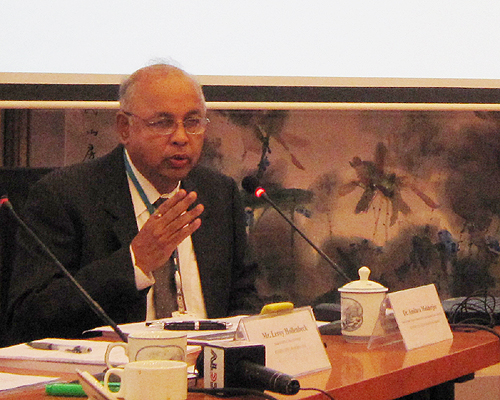|
 |
|
Dr. Amitava Mukherjee, Senior Expert of Macro Economic Policy Development Division of United Nations Economic and Social Commission for Asia and the Pacific (YU LINTAO) |
A recent UN report says the Asia-Pacific region faces another year of slowing growth as demand for its exports falls in developed nations and capital costs rise, but the region will remain the anchor of global economic stability.
The United Nations Development Program released on May 10 the 2012 edition of the Economic and Social Survey of Asia and the Pacific, the flagship publication of the United Nations Economic and Social Commission for Asia and the Pacific (ESCAP).
Commodity price volatility is a major concern for the region which faces a long-term trend of rising commodity prices, says the survey. The growth rate of the region's developing economies is projected to slow down to 6.5 percent in 2012 from 7.0 percent last year, compared to a strong 8.9 percent in 2010, estimates the annual ESCAP report. However, the slowdown in growth will help lower inflation in Asia and the Pacific, which is projected to moderate from 6.1 percent in 2011 to 4.8 percent this year, according to the publication.
The Asia-Pacific region continues to face a challenging external environment, which is why the focus of the survey is to map the landscape to help steer through turbulence and volatility.
Reduced demand in the region's traditional export markets resulting from the eurozone debt crisis and continued economic uncertainty in the United States, together with higher capital costs and loose monetary policies of some advanced economies will contribute to the slowing of Asia-Pacific growth in 2012.
Despite the slowdown, the region will remain the world's fastest growing, with China forecast to grow at 8.6 percent, decelerating from the 9.2 percent rate of 2011. Growth in India is expected at 7.5 percent in 2012, up from 6.9 percent in the last fiscal year.
Growth in Asia and the Pacific remains better than in any other region. South-South trade with Asia-Pacific in 2012 will help other developing regions, such as Africa and Latin America, further reduce their dependence on low-growth developed economies.
The survey highlights a number of key policy challenges and options for Asia-Pacific countries – amongst them: managing the balance between growth and inflation, using several inflation fighting measures beyond monetary policy alone; coping with capital flows and dealing with considerable exchange rate volatility; and addressing jobless growth and unemployment by encouraging domestic consumption to act as an enhanced engine of growth and productivity, improving working conditions and income equality.
The survey says tight global supply coupled with financial speculation in the commodity markets, global liquidity and non-economic supply shocks – such as political instability in oil-producing countries – are likely to cause persistent volatility and a long-term rise in commodity prices.
Another priority for the region is to make growth more inclusive. Levels of income inequality have grown by a worrying 15 percent in developing Asia-Pacific economies since the 1990s.
The survey says social progress in Asia and the Pacific has been hampered by increasing income inequality. Achievement of measures of the health-related and educational aspects of human development, when adjusted for inequality, is considerably lower for many countries in the region, ranging from a potential loss in achievement of 10 percent to 30 percent.
"To steer inclusive development, the Asia-Pacific region should play an active role in building development-friendly global economic environment and governance," said Dr. Mukherjee, Senior Expert of the Macroeconomic Policy Development Division of ESCAP.
More than 1 billion workers in the region are in vulnerable employment with developing countries failing to generate sufficient work opportunities in the formal sector, notes the survey. Young people are three times more likely to be unemployed than adults with the region's youth unemployment rate projected to remain at 10.2 percent in 2012.
| 